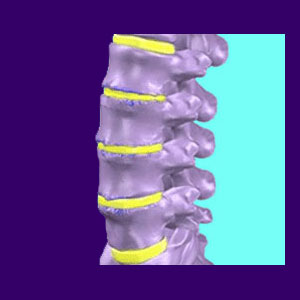
Degenerative disc disease is a condition in which the intervertebral discs dehydrate and shrink in overall size and mass. DDD causes a loss of disc height and the reduction of the intervertebral spaces between vertebrae. This condition is virtually always found in the neck (cervical) and lower back (lumbar) regions of the spine, but can also exist in the thoracic area in less common circumstances.
DDD is also called disc degeneration, disc desiccation or simply disc disease. DDD sounds like a horrible condition, but really it is just a normal part of aging. The majority of people have mild to moderate disc degeneration in one or more lumbar discs by the age of 30. Almost as many have equal degeneration in one or more of their cervical discs by the same age.
This resource section provides an incredibly thorough look at the ridiculously named degenerative disc disease in the human spine.
Degenerative Disc Disease Facts
It is quite usual for people to demonstrate large areas of disc degeneration, particularly in the lower lumbar and mid to lower cervical levels. Having 2, 3, 4 or more degenerated discs is not unheard of, nor is it necessarily something to be overly concerned about. Although degenerative disc disease is common in most people, only a small percentage actually experience any symptoms from this condition.
DDD is one of the most commonly diagnosed scapegoats in orthopedic medicine. It is almost universal, but can still be blamed for theoretically causing many varieties of back and/or neck pain. Unfortunately for the patient, it is rarely the actual cause of symptoms. This misdiagnosis is a primary contributor to the modern epidemic of back pain, since if you look for DDD in the spine, you are likely to find it in any typical healthy adult.
Disc Disease Topics
The following essays paint a vivid picture of disc degeneration and will surely help any diagnosed patient to better comprehend the fine points of intervertebral desiccation.
Disc pain is an ironic term, since spinal discs can not actually feel pain themselves.
Disc desiccation, also known as disc degeneration, is a normal process to experience as we age.
Discogenic pain is a hotly debated topic, since it theorizes that severe pain might come from tiny nerves that attach to spinal disc endplates.
Degenerated discs are most often found in the lumbar and cervical spinal zones.
The causes of disc disease include getting older, injury and idiopathic factors.
Disc disease symptoms are controversial subjects, since typical disc desiccation should not generate any symptoms whatsoever.
Being labeled with the diagnosis of disc disease should never be a surprise, since the condition is virtually universal in the adult population.
Achieving disc disease relief is difficult, since the condition is often unfairly and incorrectly blamed for causing pain. Therefore, treatments are not directed at the true causation of the symptomatic complaint.
Disc disease treatment is a highly active sector of the orthopedic community and might utilize conservative disc disease therapy or invasive approaches to care, such as disc disease surgery.
Disc disease facts often come as big surprises to diagnosed patients. If you have been told that you suffer from DDD, be sure to read the truth for yourself.
Lumbar disc disease and the equally common cervical disc disease are typically located in the mid to low sections of their respective spinal regions.
Disc disease nocebo is the actual cause of suffering in many patients who were proclaimed to have DDD, yet had no pain until the diagnosis was rendered.
Disc disease pain is rare, but it can happen. Some cases of extreme DDD can become pathological.
Understanding the psychology of DDD is a crucial part of the recovery process from disc-related back or neck pain.
For detailed information on disc desiccation, please learn from our comprehensive degenerative disc disease resource section on Herniated-Disc-Pain.Org.
Treatment for Degenerative Disc Disease
Disc degeneration has become a huge part of the back pain treatment sector for a very good reason. It is always there as an old standby for care providers to target as the potential source of pain, especially when no better structural issue is present. Additionally, treatments will never reverse the condition, nor do anything to change the desiccated nature of the disc, making ongoing care seem quite reasonable from the patient’s point of view: Oh, the disc is still degenerated. I better stay in treatment.
This amounts to a real financial windfall for the doctor. No chance for a cure. No reason to need a cure and a patient who thinks they depend on treatment just to be able to function. Unfortunately, many fall victim to this mythology of medical antiquity. This is not a universal truth, since the possibility for truly dire degeneration does exist. However, in all my years working as a patient advocate, I have seen a handful of terrible structural cases out of countless examples of people with normal spines who were nevertheless diagnosed with problematic disc desiccation. In these latter scenarios, the DDD is clearly taking the blame illogically for creating pain.
Help for Disc Disease
We think it is safe to say that despite its intimidating name, DDD is not truly degenerative, nor is it a disease. It is simply part of the process of aging. It is rarely any more painful than wrinkled skin or graying hair. That being said, it is known that DDD escalates the osteoarthritic processes and also is a contributor to many herniated discs. This is fact. However, it does not mean that the resulting arthritic change or bulging discs stand any more chance of being the source of symptoms in many patients. In some, sure, but in all, highly unlikely, as these too are normal and expected conditions which occur in virtually all our spines to a mild or moderate degree. Severe arthritis or extreme disc protrusions are another matter altogether.
I was diagnosed with DDD when I was 16 years old. I was so scared by the actual words degenerative disc disease. I pictured my spine crumbling and my vertebrae rubbing together violently with every movement. This created a powerful nocebo effect on me. It did not help that my chiropractor at the time also took full advantage of this powerful nocebo. He basically scared the life out of me and used this opportunity to force me into longterm and ever more expensive care. It is no wonder that my pain grew worse and worse.
I still have DDD. In fact, my discs are even thinner now. My back pain never came from degenerative disc disease, despite the diagnosis. You have it too, as does your doctor and every other adult you know.
Please, do not fear DDD. Just learn the facts of the condition before rushing into any treatment or surgery. Our proven Cure Back Pain Forever Program can not only manage existing pain and prevent new pain, but can also cure symptoms of many different diagnoses without any risk or major costs. No wonder the program has earned praise from so many doctors and healthcare organizations worldwide.
Read more about disc disease back pain and disc disease neck pain.





